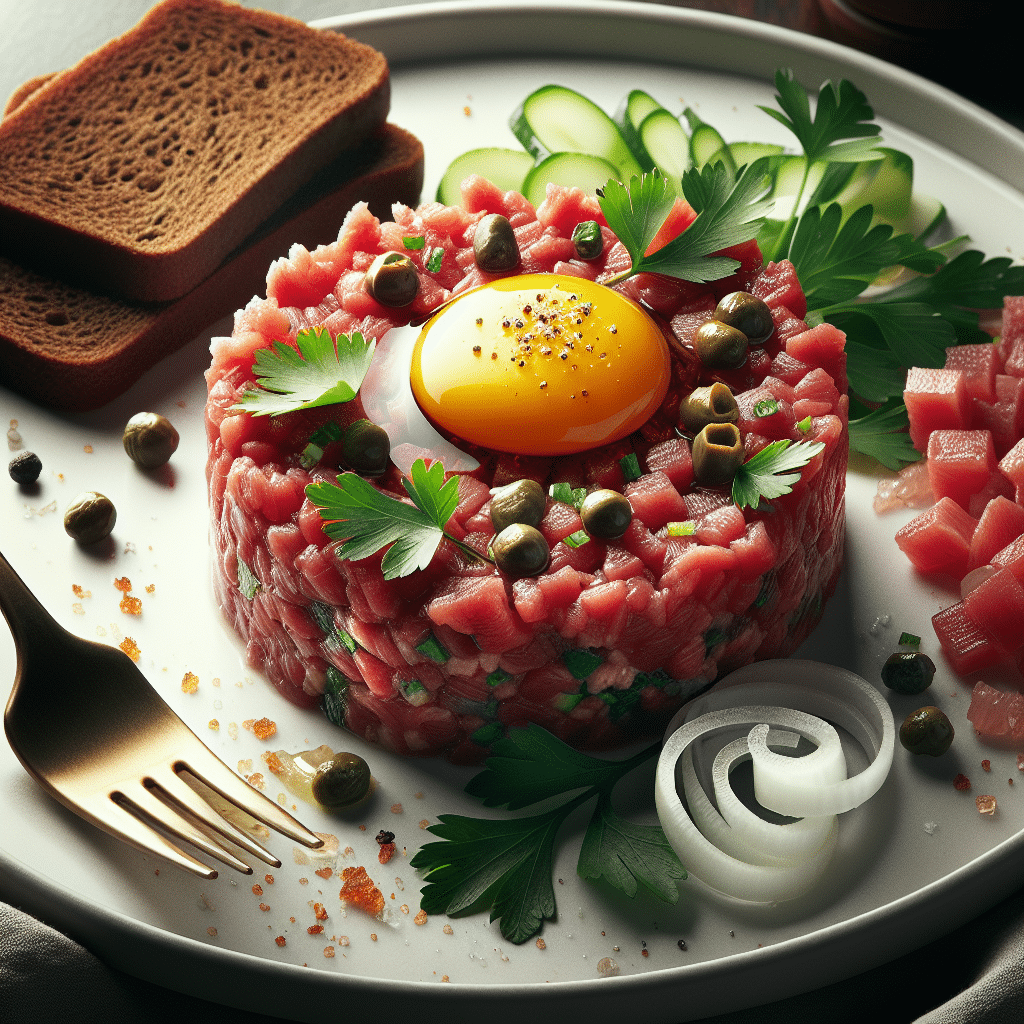Introduction to Steak Tartare
Steak tartare is a classic dish, traditionally consisting of raw minced or finely chopped beef, seasoned and typically served with various accompaniments. This delicacy is often garnished with onions, capers, and sometimes a raw egg yolk. Originating from the tartar tribes of Central Asia, it has evolved into a staple in French cuisine and has gained popularity worldwide. While steak tartare may seem intimidating due to its raw meat base, it is a dish renowned for its rich flavors and texture, appealing to adventurous eaters. When prepared with high-quality ingredients, steak tartare is a safe and delicious option for those looking to experience the depth of flavor offered by expertly seasoned raw beef.
Understanding Steak Tartare
Steak tartare is not just a dish; it represents a culinary tradition that emphasizes freshness, quality, and the art of flavor pairing. Made from high-quality beef, the meat is typically sourced from cuts like tenderloin or sirloin, renowned for their tenderness. The meat is either finely chopped or minced, and seasoned to enhance its natural flavors. This method of preparation allows the dish to be served raw, highlighting the quality of the ingredients.
History of Steak Tartare
The history of steak tartare is as rich as the dish itself. The name is said to be derived from the Tatar people, who historically consumed raw meat. However, the modern interpretation of steak tartare is largely influenced by French cuisine, where the dish was popularized in the late 19th century. Initially, it was served as an appetizer in high-end restaurants, showcasing the chef’s skill in preparing raw meat. Over time, variations have emerged, including the use of different types of raw meat and alternative seasonings, demonstrating its versatility across culinary landscapes.
Ingredients of Steak Tartare
At its core, steak tartare comprises a few essential ingredients:
- Raw Beef: High-quality beef is crucial for safety and flavor. Tenderloin or sirloin are popular choices.
- Seasonings: Common seasonings include salt, pepper, Worcestershire sauce, Dijon mustard, and a touch of olive oil.
- Accompaniments: Traditional accompaniments often involve capers, finely chopped onions, and sometimes pickles or herbs for added complexity.
- Egg Yolk: A raw egg yolk is frequently placed atop the tartare for richness and to enhance the overall texture.
Preparation of Steak Tartare
Preparing steak tartare requires attention to detail and a focus on hygiene. Follow these steps for a traditional tartare:
- Choose Quality Meat: Sourcing fresh, high-quality beef from a trusted butcher is the cornerstone of any great steak tartare.
- Chill the Meat: Keep the meat cold until ready to use. This not only aids in easier handling but also helps preserve freshness.
- Finely Chop or Mince: Use a sharp knife to finely chop or mince the beef, ensuring an even texture for optimal flavor absorption.
- Season Generously: Add Worcestershire sauce, Dijon mustard, salt, and pepper, adjusting to personal taste.
- Mix and Plate: Gently combine the ingredients, then plate the tartare. Finish with an egg yolk and any garnishes you prefer.
Nutritional Considerations
Steak tartare can be a nutritious option, rich in protein and essential nutrients. However, because it involves raw meat, it also carries some health risks. Consuming raw beef can pose a risk of foodborne illnesses such as E. coli or Salmonella. Here are some important nutritional points:
- Protein: Steak tartare is an excellent source of protein, crucial for muscle repair and overall health.
- Iron: Raw beef is rich in heme iron, which is essential for oxygen transport in the blood.
- Vitamins: The dish also provides B vitamins, including B12, which supports brain health and metabolism.
- Caloric Content: Depending on the preparation, steak tartare can range from 200-400 calories per serving.
Serving Suggestions
When serving steak tartare, presentation is key. Here are some serving suggestions to elevate your dish:
- Accompany with Toast: Serve the tartare alongside toasted baguette slices or crispy crackers for texture.
- Add a Salad: A light side salad of arugula or mixed greens drizzled with vinaigrette can balance the richness of the tartare.
- Pair with Wine: A glass of red wine, like a light Pinot Noir or a fuller-bodied Merlot, can complement the flavors beautifully.
- Experiment with Flavors: Consider adding different spices or sauces, such as a spicy aioli or chimichurri, for a unique twist.
Popular Variations of Steak Tartare
While traditional steak tartare remains a favorite, numerous variations cater to diverse palates. Here are a few popular options:
- Tartare de Thon: Made with finely chopped raw tuna instead of beef, providing a different flavor profile while retaining the essence of tartare.
- Steak Tartare à la Française: A classic version featuring French seasonings and served with a raw egg yolk on top.
- Italian Carne Cruda: Often includes olive oil and lemon, accentuating the natural flavors of the meat.
Safety Considerations
Eating raw meat does come with risks. Here are some essential safety tips:
- Source Meat Wisely: Always purchase beef from reputable sources known for their safety standards.
- Maintain Cleanliness: Ensure all utensils and surfaces are clean before and after preparing the dish.
- Keep Refrigerated: Store ingredients in the refrigerator until you are ready to serve to minimize bacterial growth.
Frequently Asked Questions
Is steak tartare safe to eat?
When prepared with fresh, high-quality ingredients from a reliable source, steak tartare can be safe to consume. It’s important to follow proper food safety practices during preparation.
What type of meat is used in steak tartare?
Steak tartare is typically made with high-quality cuts of beef, such as tenderloin or sirloin.
What do you serve with steak tartare?
Common accompaniments include toasted bread, crackers, various condiments, and garnishes such as capers and onions.
Can I make steak tartare with other meats?
Yes! Variations of steak tartare can be made using raw fish such as tuna or salmon, as well as other types of meat, depending on personal preferences.
How should steak tartare be seasoned?
Steak tartare is typically seasoned with salt, pepper, Dijon mustard, and Worcestershire sauce, with additions like capers and chopped onions to enhance its flavor.
Conclusion
Steak tartare is not merely a dish; it is an experience that showcases the elegance and craft of raw culinary preparation. When made with care, it offers a delightful exploration of flavors and textures, marking its place as a cherished delicacy in French cuisine and beyond. By understanding its history, preparation methods, and flavor profiles, you can appreciate this dish in all its glory and perhaps even be inspired to create your own version at home.



